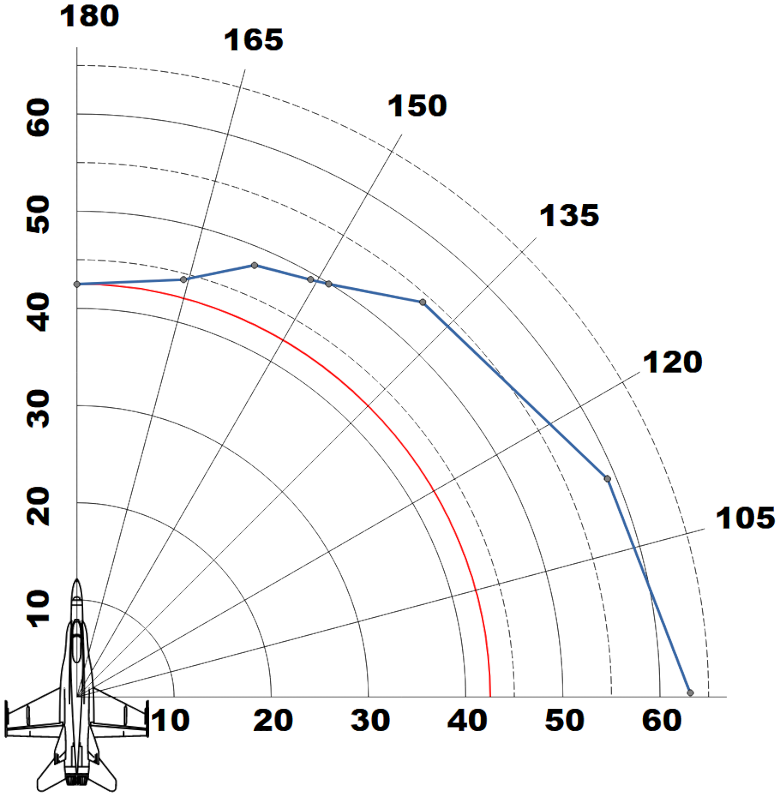Video
The RCS, acronym for Radar Cross-Section, is a concept made popular, or less of a niche if you will, in recent years by the arrival of fifth-generation fighters such as the F-35. In extremely basic terms, the RCS is linked to how far radars detect a target, and several parameters are involved, for instance, the usage of radar-absorbant paints or ad hoc design choices. However, none of this is present in DCS yet, and third-party developers are approximating the effects on the detection range themselves. Heatblur and their brilliant APQ-120 simulation portray various effects impacting the detection range. From the virtual crew perspective, distance, target aspect angle, range, and external loadout are the most tangible variables.
Aspect versus detection range
Regarding aspect versus detection range, a long list of factors determines how far a target can be seen. The waves emitted must reach the target and return to the radar system, thus covering the distance twice. Intuitively, hot targets usually show a more compact and cleaner silhouette than when flanking or beaming, and radio waves “sort of see” a similar thing. Therefore, the crew will observe more robust returns and increased detection range as the aspect angle decreases.

Example
This sketch shows the results of the example shown in the video: the red arc represents the detection range when the target is hot. This is how many modules represent the RCS in DCS today: statically.
The blue line represents the gathered data points, plus an additional value collected later for a beaming target. A hot F-16 is detected at circa 42 nautical miles; a beaming one at AA 89 at 62 nautical miles — an impressive increase of almost 50%.
Albeit approximative, this sketch clearly shows the work that Heatblur has put into representing the APQ-120 in the most realistic manner possible.

The following is, instead, an AN/AWG-10 example, showing the 85% probability of detection as a function of the target aspect and range. The target is a high-flying Tu-22 “Blinder”.

If there is enough interest, I can put together a more thorough model, so let me know in the comments below. That being said, many parameters affect the radar, especially during a mission, so a perfect model of the RCS is neither empirically achievable nor useful.
RCS and Detection Range: external ordnance.
The presence of internal ordnance bays in the F-35 is not a mere design choice: external payload dramatically increases drag and can affect the RCS of the aircraft.
Albeit minimal and quantifiable as single digit percentage, the effects are present and Heatblur has implemented them in their APQ-120 simulation.
External ordnance affects low-RCS aircraft more than high-RCS ones, hence the presence of internal weapon bays in fighters such as the F-35. In DCS, the importance of this factor is minimal, given the relative type and age of the represented aeroplanes. Even if there were, the simulation of 5th-gen fighters would require a central RCS API that provides the same standard of information to every radar simulation in the game. Since DCS is a game and RCS models are incredibly complex, they won’t have to be 100% accurate, and Heatblur’s is already a solid and valuable implementation.
These last three examples have shown how external ordnance affects the detection range. However, the aspect angle is a vastly more important variable, and the crew can use changes in such variables to increase their Situational Awareness. Imagine, for example, a group capping on the radar scope and moving almost perpendicularly. Then, they disappear. If they reappear, they may have turned and resumed their CAP track. If they don’t, they may have turned cold… but also hot. Nevertheless, something has changed, and this information alone is very valuable in terms of SA.
Attention to small elements and undertones and the reactions they cause differentiate a standard crew from an excellent crew.
DCS vs “real” RCS values
The following table shows the radar cross-section for several aeroplanes and their DCS equivalent. Sources and links are available below.
According to the values elaborated by Quaggles, the RCS of the three observed aeroplanes in DCS is the following: F-16, 4 square metres; F-14, 6 square meters; and CS-101, 2.5 square meters.

Sources
“Real” RCS: https://www.globalsecurity.org/military/world/stealth-aircraft-rcs.htm
DCS RCS (Quaggles): https://github.com/Quaggles/
